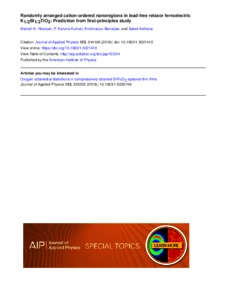Niranjan, Manish K and P, Karuna Kumari and Banerjee, Krishnarjuna and Asthana, Saket
(2018)
Randomly arranged cation-ordered nanoregions in lead-free relaxor ferroelectric K1/2Bi1/2TiO3: Prediction from first-principles study.
Journal of Applied Physics, 123 (24).
p. 244106.
ISSN 0021-8979
![[img]](http://raiithold.iith.ac.in/4155/1.hassmallThumbnailVersion/Journal%20of%20Applied%20Physics_123_24_1-12_2018.pdf)  Preview |
|
Text
Journal of Applied Physics_123_24_1-12_2018.pdf
- Published Version
Download (2MB)
| Preview
|
Abstract
First-principles density functional calculations are performed to investigate the lattice dynamics, Infrared reflectivity, and Raman intensity spectra of a lead-free ferroelectric K1/2Bi1/2TiO3 system. In particular, the A-site cation ordering in K1/2Bi1/2TiO3 and its effects on lattice dynamics and the Raman spectrum are explored. The results suggest that the cation ordering at the A-site in K1/2Bi1/2TiO3 significantly influences its Raman spectra. From the analysis of theoretical and experimental Raman spectra, it is suggested that randomly arranged cation ordered nanoregions with different A-site orderings are formed in K1/2Bi1/2TiO3 samples. The random arrangement is favored by entropy contributions to free energy and may explain the lack of observed long-range A-site cation ordering in K1/2Bi1/2TiO3. Further, it is suggested that partial A-site cation ordering may also occur in K1/2Bi1/2TiO3 favored by kinetic factors during sample preparation. The Born effective charges of K and Bi ions at the A-site are computed and found to be significantly disparate, thereby suggesting hetero-polar activity at the A-site in K1/2Bi1/2TiO3. The formation of A-site hetero-polar cation ordered nanoregions and their random or/and partially ordered arrangement in K1/2Bi1/2TiO3 may play an important role in the determination of its relaxor properties apart from the dominant role played by polar nanoregions. The computed Infrared reflectivity and Raman intensity spectra are expected to provide benchmark first-principles results for further analysis of experimental spectra and results.
Actions (login required)
 |
View Item |


 Altmetric
Altmetric Altmetric
Altmetric